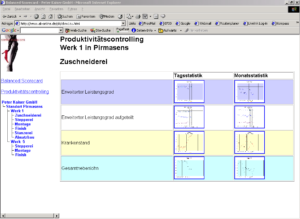Diet tips for entrepreneurs
by Dr. Götz-Andreas Kemmner
Spring and the time for diet suggestions is just around the corner. They promise to slim you down for the summer in just a few days. However, staying slim ultimately depends on a balanced diet and moderation. The same applies to companies.
Obesity and poor nutrition due to the wrong product portfolio lead to earnings weaknesses that can quickly result in the need for restructuring or even death by insolvency. For this reason, you should make sure you have a balanced product portfolio and regularly work off sluggish fat deposits. The tools for diets – whether for companies or people – hardly differ: while classic diets use calories and nutritional value tables to control your diet, corporate diets use contribution margin calculations to determine the “lazy” product groups and products that are bad for you and that you need to take care of. Now every entrepreneur will say: “We’ve been doing this for a long time”, but the crux lies in the detail. For the majority of companies, their own “nutritional value table” (= calculation system) is not correct.
Is your nutritional table correct?
Unfortunately, the accuracy and informative value of costing systems are often poor. The most common errors made in costing systems are incorrectly applied utilization rates, incorrect machine hour rates, incorrect surcharge factors and/or surcharge factors that are too high. For example, a plant manufacturer in the Rhineland was constantly struggling with the problem that older machine tools were better utilized in production than new, more productive machines. It turned out that the calculation for older machines was based on incorrect, too low machine hour rates due to the lower residual book values. Despite the longer process times compared to modern machines, this resulted in supposedly lower production costs. Not even the costs for the underutilization of modern machine tools were taken into account in the cost analysis. This is just one example of many cases whose solution seems crystal clear in retrospect. Such technical errors are often only recognized when things get financially tight, sometimes even later. In many companies, the decisive causes of inadequate costing systems lie where the “feeding tubes” and knowledge of business people and external auditors end: In the no man’s land between business management and technology.

Don’t count the peas
While in some medium-sized companies there is nothing that could seriously be described as cost accounting, other companies have detailed their cost accounting systems to such an extent that they are incomprehensible for users and confusing for controlling. This then annoys the “customers” of cost accounting and, above all, those who do not navigate the jungle of business terminology on a daily basis. For this reason, the interfaces between the technical and commercial areas must be clearly defined in order to ensure the quality of the input data and to prepare the output for non-BWL employees in such a way that they also understand it. This goal is usually achieved with technical and organizational KPI systems, which many managers and employees of a company can handle better than pure cost indicators. In our experience, where such technical and organizational KPI systems exist and the figures are displayed on a daily basis, changes are reacted to quickly, as the possible causes of a deviation from the target are always visible in addition to the KPI. Conventional business management figures, on the other hand, condense operational events into abstract monetary values and thus often obscure the connection between cause and effect. You should therefore take a closer look at your key figures.
In restructuring projects, for example, the monitoring of key figures for inquiries, quotations and orders, delivery capacity, inventories, added value and quantities is an important first measure, because changes – for better or for worse – can already be recognized from such figures when they are not yet apparent in the classic business figures.
Due to the high use of technology in most companies, the consistent tracking of maintenance and servicing hours and the consumption of operating materials for the systems is also becoming increasingly important. For example, the maintenance manager of a northern German mechanical engineering company found that the maintenance and servicing costs of its own machine tools used for the production of test series of a new component increased significantly and the availability of these machines decreased considerably. This change was not included in the price calculation due to unadjusted hourly machine rates. After drawing attention to the problem, a careful recalculation shows that the supposed profit of EUR 0.69 per unit turned into a loss of around EUR 0.54 per unit. At approx. 1500 units per working day, this amount would have added up to over 200,000 euros per year; with an originally planned pre-tax profit of 1 million euros, of which approx. ¼ was to result from the production of this component.
Conversely, we were able to recognize the success of our restructuring measures at a medium-sized contract manufacturer through consistent controlling of shift performance and the causes of downtime and disruptions, even when the BWA still reflected the downward trend.
When your favorite dish is on your stomach…
Only with the help of a proper nutritional value table (= calculation system) can it be determined whether a company has a product portfolio with nutritional value. Optimizing your own service portfolio is often no walk in the park. Sometimes it is necessary to sort out value chains: For example, if product A no longer contributes any revenue, you have to consider whether you have the time, money and possibilities to make it profitable again or whether you have to stop producing it. In many cases, the necessary procurement, sales and production activities have to be discontinued.
In such cases, it is important to reach a decision as objectively as possible. It is important to be aware that each party in the company is pursuing its own goals. There is nothing fundamentally wrong with this, because only those who identify with their task can perform accordingly. This leads to a situation that is fatal for change, where “division heads” consciously or unconsciously boycott the change process. And believe me: There are such departmental egos in every one of our consulting projects! Identification inevitably leads to a narrow perspective. To avoid this tunnel vision, external moderation of a streamlining, downsizing or restructuring process is therefore recommended. In any case, however, the alternative courses of action must be objectively compared in the form of scenarios and their effects weighed up. Only then should you make a decision. A simple business plan in which the scenarios are calculated in monthly planned P&Ls for the next 24 months is best suited for this.
Fast slimming required
Once fat deposits have been identified, and contrary to the recommendations made by human physicians for humans, quick action is required after the decision to streamline performance or slim down the company. If you act too slowly, you will unsettle customers, suppliers and, last but not least, your employees. And this often leads to valuable employees saying goodbye to the company, first internally and then “physically”. You should also avoid postponing the decision in order to give yourself the opportunity to improve the situation. Although this is honorable, it usually leads to the project getting stuck. The “food combining diet” should therefore be carried out consistently and quickly, because otherwise it can happen that the financial reserves are no longer sufficient to pay for the necessary diet. The company becomes insolvent and, at best, is still capable of being restructured.
In the short term, only radical diets, such as discontinuing unprofitable products and their value chains, laying off staff (especially in indirect areas) and eliminating organizational friction losses, can usually help. Fortunately, most companies are not yet at this threshold in terms of health. A targeted workout can therefore reduce fat deposits and make the body fit again in the medium term. Companies should focus on five basic exercises:
- Concentration on a product portfolio in line with the market, because what does not make money in the medium term must be replaced.
- Coordination of product and process (product and process design to cost), as 80% of value creation costs are already determined during development.
- Designing market-synchronized processes in procurement, production and distribution, because if you can’t breathe with the market, you won’t be able to breathe.
- Economical production and information technology, because many systems and software systems cost more than they deliver.
- Building lean and flexible infrastructures, because the infrastructure itself does not create value.
With these five exercises, attention must be paid to correct posture and mental attitude: Measures must be implemented in such a way that costs fall relative to sales and the marginal employment level (= capacity utilization level at which money is just still being earned) is reduced. And check your exercises using informative nutritional value tables. But be careful when going it alone: Not only radical cures, but also these five corporate workouts pose health risks if they are not carried out properly. Companies that want certain success without damage should seek advice and support when implementing the measures. Companies only deal with these workouts occasionally; “nutritionists” on an ongoing basis…

